Who is ready for one of the most gorgeous DIYs to hit my blog thus far? I am sharing a DIY dining table tutorial today, and it will be the first of 2…because this gorgeous beast was not for me. If you are looking for a great way to get a custom size dining table, at a much more affordable price, then this tutorial is for you! Hopefully you can build the perfect table
This post contains affiliate links. There are power tools needed in this post. I am not responsible for injury. Be sure to always work with the utmost safety so you can keep DIYing!

DIY Dining Table
As I said in the first paragraph – this DIY project wasnt for me. My friend Val got a new home recently as a vacation and rental property – read more about that here.
She needed a large dining table for the house – partially due to a huge dining room, but also because they will be entertaining their often. Because of that they were looking at some pretty monster tables.
If you haven’t been furniture shopping recently – getting anything takes so long. Trust me – we have been renovating and furnishing and it has been downright painful. Add that to the fact that the tables she was eying were thousands of dollars, with few options to pick from, she came to me with the proposition of building her a table as a blog project.
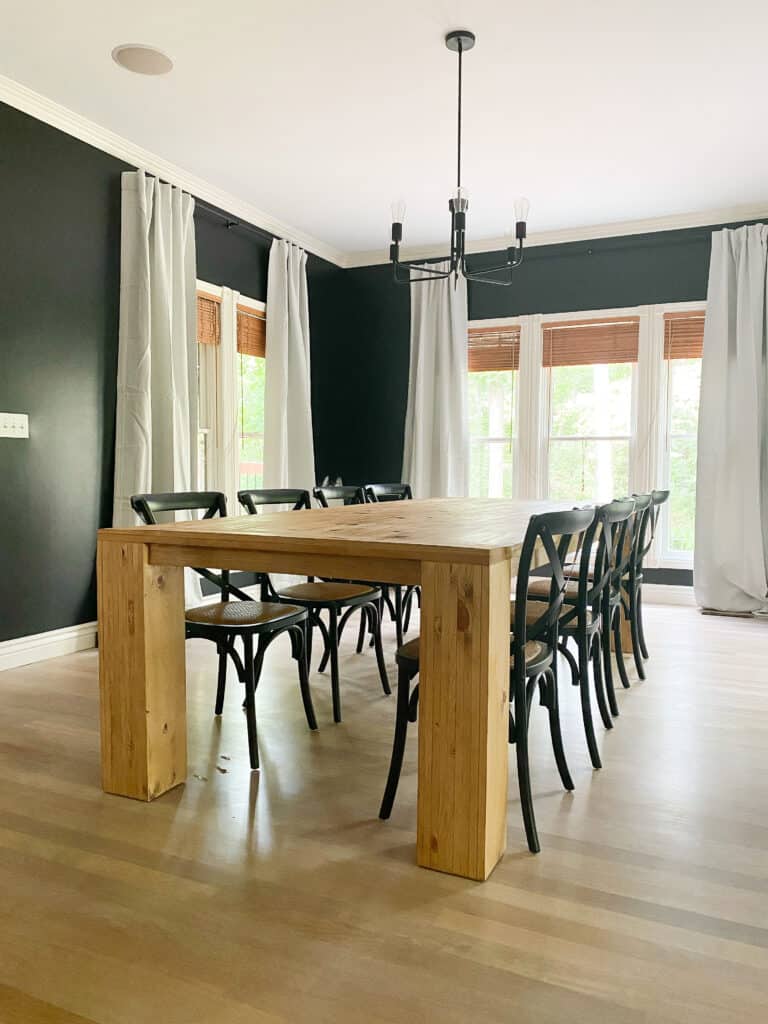
My first thought? That is terrifying – we normally only build things for our own use. But, there is nothing better than getting a great tutorial in for all of you and not having to spend a bunch of money. We got to planning, and between Val and myself came up with a pretty good plan.
Designing the DIY Dining Table
Val sent me a few different options of tables she was looking at. I LOVED this one, and this one. Both were simple in design but had a bit more character and modern edge than just a basic table design.
Due to the size of the table we opted for VERY big legs to support the beast. You guys this bad boy is 106×48 inches. (not to worry I will share how to pick lumber that is best for your perfect size table – as most of you likely don’t need this size.)

When it comes to DIY you want to make these unique and fun, but I also think there is nothing better than finding a high end table that you can make your own. We landed on a really simple design that had some edge. Overall I think we came up with a stylish look that would look good in so many homes, no matter your decor style.
Why DIY?
DIY can be the best thing in my opinion. Aside from time and cost, DIY has a few other great benefits when it comes to furniture. We actually have a custom dining table that we have had for years (well before we started doing any woodworking) and I have enjoyed the benefits of a custom table myself – so I feel like I can really weigh in on this.

First of all – When you get a solid wood custom table you know there are no heavy varnishes and such on them. If you change your mind on stain, or an accident happens, some sanding and staining will have your table good as new.
That might not be of importance with smaller pieces but with a large and expensive piece like a table that piece of mind has been AMAZING for us.

With our current table about 3 years after buying it I decided I didnt love the stain, and we sanded the whole thing down and stained it much lighter. It was the best decision because it made me fall back in love with the table in our home for less than $20 in supplies.
Custom is also amazing for size. Let alone length, width on tables has lessened a lot over the years. When we were looking to buy a dining table years ago I was so frustrated that the width of current tables was so small. The table we had been using was an antique and was about 48 inches wide.
I LOVE having a wider table so that I can have decor or food on the table while still sitting comfortably, so going custom allowed me to retain that width of table in our space.
Although lumber costs are high right now – you can still save a lot of money buy DIYing a table, and you will get something high quality and solid wood.
Okay so – now I have given you all the ins and outs to how we came up with this DIY dining table design, and why we did it, so now lets get to actually building the table! This post will have a step by step guide both in the blog post and in a printable version.

A couple of major things to note before you start shopping:
When you are shopping for lumber for something like this you don’t want to skimp. That said – lumber prices are pretty high right now, so you dont have to get the best of the best.
When you are picking lumber you want to check to see if each piece is high quality. Turn the pieces on their edges and check for any warping and be picky!

When you are building – be aware of humidity and temps. We live in Missouri and it is humid as all get out in the summer, and we dealt with warping in the hot summer and lost some lumber. You will also want a flat surface to do your building on if possible.
Last – when it comes to stains you will want to test them. But we also learned that some stains oxidize when they have been opened. So if you settle on a stain, before you start on the table test that can one more time!
Those three tips will save you a whole lot of trouble when you are creating this bad boy!

DIY Dining Table Supply List
(depending how you work best, I also have a printable shopping list and instructions towards the end of this, so if that works best for you, you can go that route!)
Supplies for Staining
- Wood Stain – For our table we did a 50/50 mix of special walnut and golden pecan both from Minwax.
- Wood Conditioner
- Polyurethane – We went with a matte finish
- Rags for Stain
- Foam roller
Tools
- Sander and Sanding Disks
- Planer – we got this inexpensive one – but it is very optional.
- Miter Saw – We have personally owned both this inexpensive one and this nicer one. Clearly we love the nicer one, but if you won’t be doing many projects, the first one was amazing for us!
- Drill
- Kreg Jig
- (possibly – we didn’t need this, but I explain why you might in the table top instructions) Circular saw
Other
- Wood Glue
- 1 inch Kreg Screws
- 1.25 inch screws
- Clamps – You need several clamps. I am linking to the ones we have. These little guys are great to have lots of them, Then having a few of these are great for the legs, and we also grabbed 2 of these which were amazingly helpful.
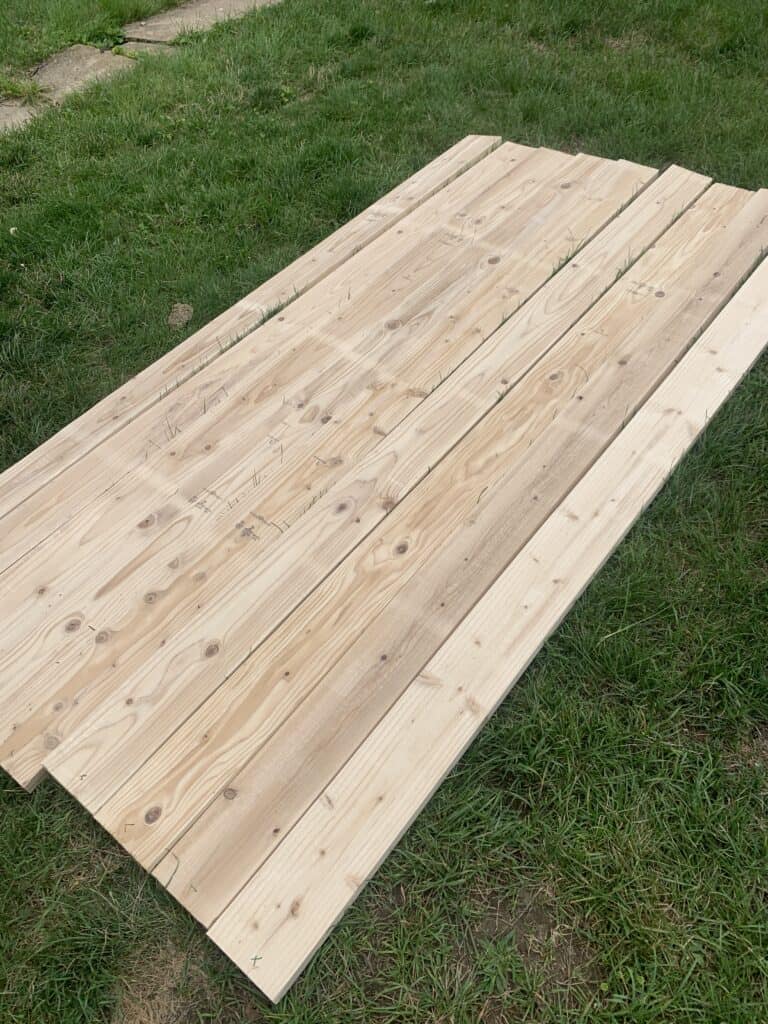
Lumber
I will list exactly what we used – but modify the table top and aprons based on the size you need. The legs should remain the same for any size table top. We personally have the best luck getting lumber at Menards, but I know not everyone has a Menards near them.
Table Top:
- 8 – 1×12 x 8 foot pine boards
- 2 – 1×6 x 10 foot pine boards ( you will want these end pieces no matter what, so if you don’t need a super long board you might be able to drop the 1×16’s to shorter sizes
- 2 – 1×3 x 10 foot pine boards (apron)
- 1 – 1×3 x 8 foot pine board (apron)
- 2 – 1×3 x 8 foot furring strips
Legs:
- 8 – 1×8 x 10 foot pint boards
Step by Step Plans to Building your DIY Dining Table
Take the order of the table top and the legs with a grain of salt. They both need to be done and in whatever order works best for you. I am going to start with the legs but feel free to build your table top first. There are also some pretty good step by step photos integrated into the post that are hopefully helpful.

Building the Table Legs:
- This is just a case of wood gluing and clamping all the boards together. Lay your first board down and put down wood glue. Lay your next board on top, and repeat until they are all stacked.
- Now you need to clamp them. We used our two big clamps and 4 other smaller clamps. Use as many clamps as you can, and add weight in between. Then walk away from these for 24+ hours.
- Once the glue is dry, remove the clamps.
- Now you need to sand all 4 sides of the piece.
- Cut the Long piece into 4 equal parts.
- Sand down the ends to be smooth, and set the legs aside.
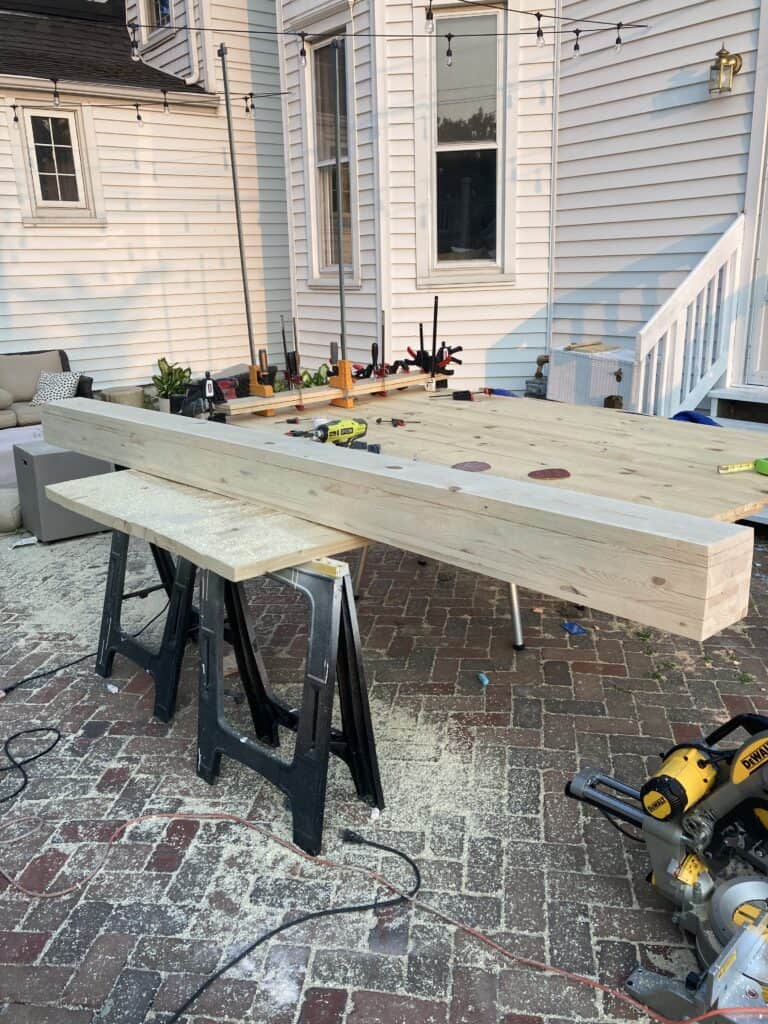
Building the Table Top:
1. Sandwich each of your 1×16’s and 1×6’s into sandwiches. You want each of them to end up looking like a 2×16/2×6. Use the same method as before- Wood glue, clamp and weight, then let sit for 24 hours. Depending your number of clamps you may need to do this in phases.

2. Once the clamps are removed we are going to focus on the 1×16 boards. Add just a few pocket holes (just the holes right now0 to the under side of your boards so you can join the 3 together. (Keep in mind if you are going to end up cutting this section shorter don’t put the pocket screws in an area you will end up cutting off).
3. Use wood glue between all three sections and clamp your table top together. Pay close attention to low level this is! We used these large clamps for the tabletop.

4. While it is clamped and the glue is still wet add your pocket screws. Again in this whole process this is the most important step to make sure its fully level, so take your time!
5. Once that is dried and you remove your clamps you will want to plane or sand the ends to be really smooth.

6. Now it is time to add your 6 inch end pieces. One thing that is really important is to measure your end of your table so you can cut the now 2×6 board to the width of each side. Measure each side. (that is why I told you to get a 10 foot board instead of an 8 foot board – with the 8 foot you have no room for extra and you will likely need just a tiny bit more than 48 inches).
7. Add pocket holes to the under side of the 6 inch piece.
8. Add wood glue, clamp, then pocket screw your end pieces on. Again let this sit for 24 hours.
9. Remove the clamps and the starting stages of the table top are complete!
Attaching your Legs to the Table top
Your next step is going to be attaching those big legs to your table top. You should have 4 equally cut legs that have been sanded down.
- You will add pocket holes on two sides of the legs.
- Add wood glue to the top of the leg, and pocket screw and wood glue each leg on to the corners.
- Let this dry for 24 hours.

Adding an Apron and extra support slats
The apron of a table is basically support pieces that in my opinion elevate the overall look of the table.
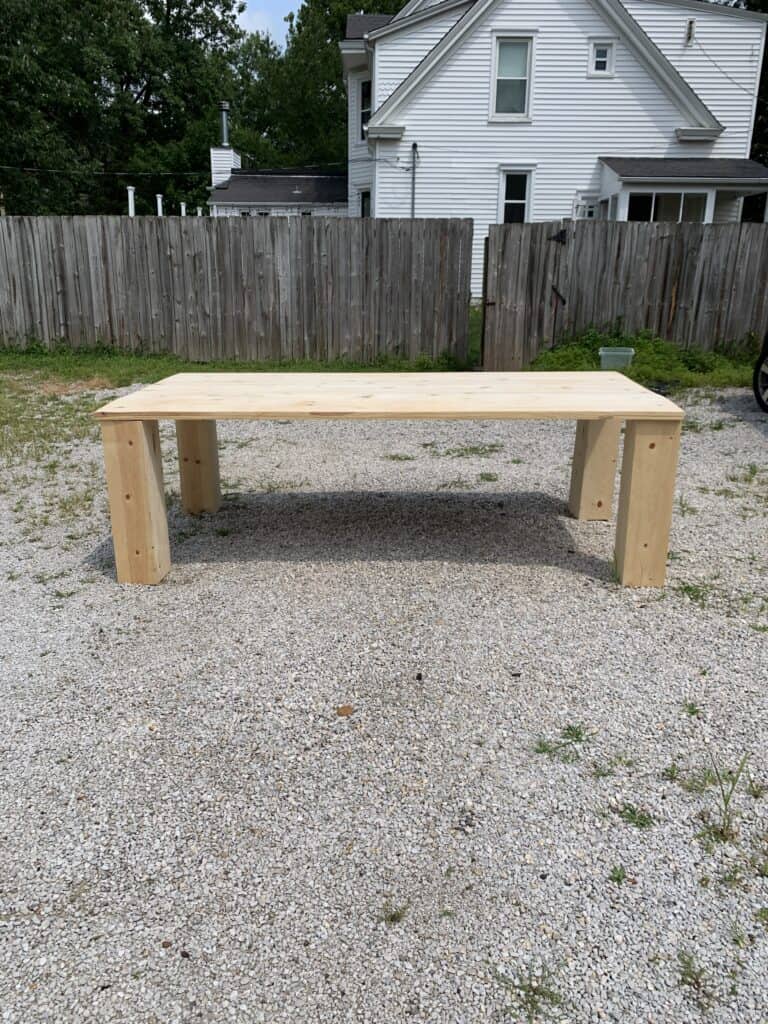
- You are going to cut your 1×3 pieces of pine to fit between the legs on all 4 sides of the table.
- Add pocket screws and wood glue to the ends.
- Pocket screw into the legs of the legs of the table.
- We then also added support pieces using the 3 inch furring strips to the bottom of our table because of the overall size. Those were simply screwed in with 1.25 inch screws. That step is not necessary if your table is not huge like the one we built.
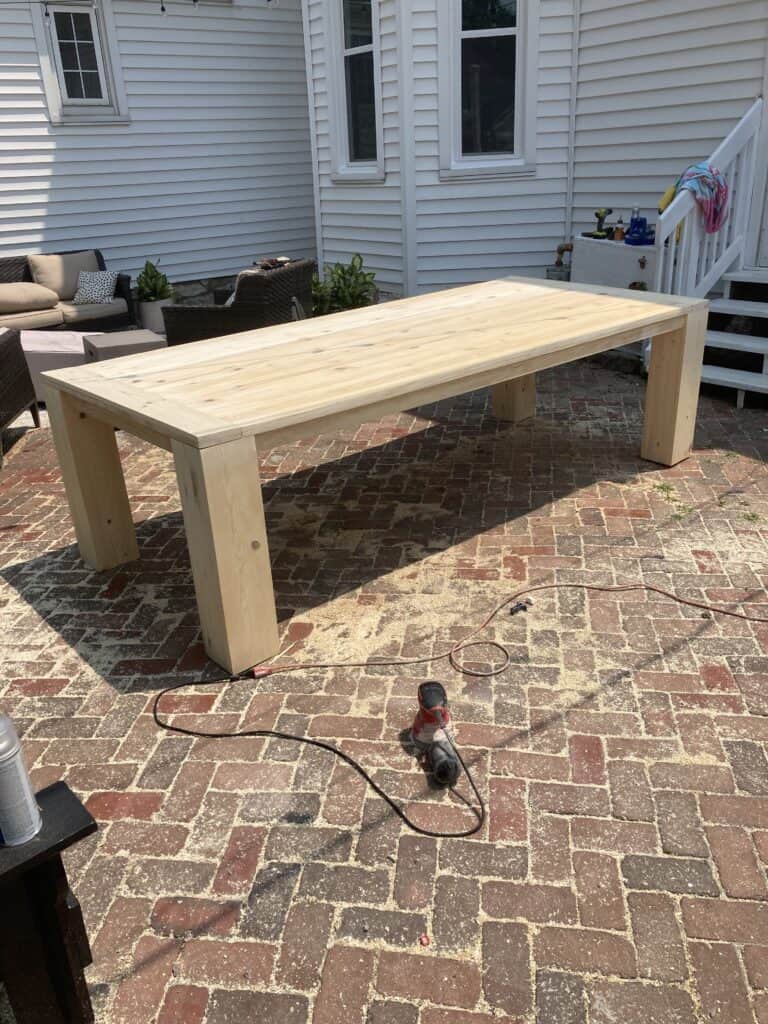
Finishing your DIY Table
Now you should structurally be able to look at your table and see a fully built and gorgeous table. But there is still quite a bit of work to do!.

- Wood filler – you need to add wood filler to all the cracks and crevices. You’ll use a good amount of wood filler, especially on those legs.
- Let it dry then sand – and SAND IT WELL. This is also your chance to sand every edge and just get everything looking perfect!
- Once your table is fully sanded it is time to wood condition your table. This is an important step! Essentially adding wood conditioner will make your table take the stain in a less blotchy way.
- Let the wood conditioner dry and now you can stain. Like I said above – we tested our stain on a sanded piece of pine. The colors we went with are in my supply section.
- Once the stain is fully dry you can add your polyurethane as the final step. This seals the table to keep it nice. Use a foam roller to apply the poly and allow that to dry for a few days before you use the finished product. You may want to add more than one coat – you be the judge!

AND NOW your wood dining table is done. Don’t forget I offer Printable plans below incase that is easier for you as you are building.
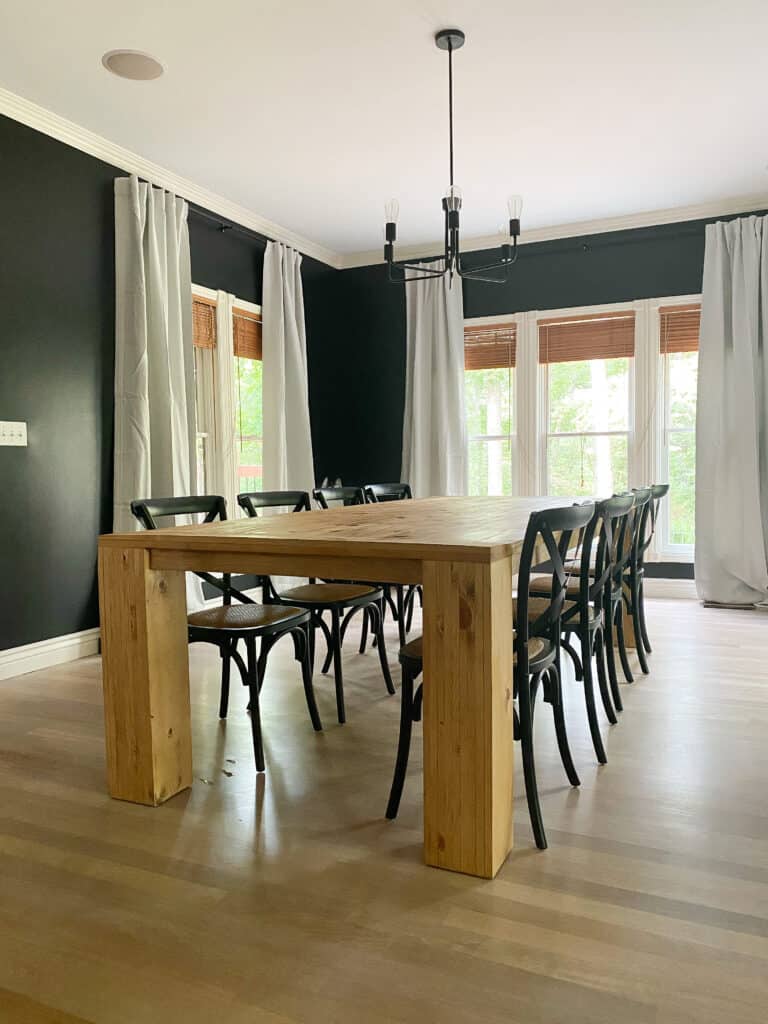
Free Printable Plans for DIY Dining Table
Below you should be able to print the step by step plans for this DIY to keep with you while you are building.
DIY Dining Table Tutorial

Use this tutorial to create a DIY dining table that is custom for your space.
Materials
- 8 1x12 by 6 foot or 8 foot pine boards pending length of table desired
- 2 1x6x 10 foot pine boards
- 2 - 1x3x 10 foot pine boards
- 1 - 1x3x 8 foot pint board
- 2 8 foot furring strips
- 1 inch pocket screws
- 1.25 inch screws
- Wood Glue
- Wood filler
- Polyurethane
- Stain
- Wood Conditioner
- 8 - 1x8 x 8 foot pine boards
Tools
- Miter Saw
- Sander
- Drill
- Kreg Jig
- Planer (Optional)
- Circular saw (possible pending desired length of table)
- Clamps
Instructions
Step by Step Plans to Building your DIY Dining Table
Take the order of the table top and the legs with a grain of salt. They both need to be done and in whatever order works best for you.
I am going to start with the legs but feel free to build your table top first. There are also some pretty good step by step photos integrated into the post that are hopefully helpful.
Building the Table Legs:
This is just a case of wood gluing and clamping all the boards together. Lay your first board down and put down wood glue. Lay your next board on top, and repeat until they are all stacked.
Now you need to clamp them.
We used our two big clamps and 4 other smaller clamps. Use as many clamps as you can, and add weight in between. Then walk away from these for 24+ hours.
Once the glue is dry, remove the clamps.
Now you need to sand all 4 sides of the piece.
Cut the Long piece into 4 equal parts.
Sand down the ends to be smooth, and set the legs aside.
Building the Table Top:
1. Sandwich each of your 1x16's and 1x6's into sandwiches. You want each of them to end up looking like a 2x16/2x6. Use the same method as before- Wood glue, clamp and weight, then let sit for 24 hours. Depending your number of clamps you may need to do this in phases.
2. Once the clamps are removed we are going to focus on the 1x16 boards. Add just a few pocket holes (just the holes right now0 to the under side of your boards so you can join the 3 together. (Keep in mind if you are going to end up cutting this section shorter don't put the pocket screws in an area you will end up cutting off).
3. Use wood glue between all three sections and clamp your table top together. Pay close attention to low level this is! We used these large clamps for the tabletop.
4. While it is clamped and the glue is still wet add your pocket screws. Again in this whole process this is the most important step to make sure its fully level, so take your time!
5. Once that is dried and you remove your clamps you will want to plane or sand the ends to be really smooth.
6. Now it is time to add your 6 inch end pieces. One thing that is really important is to measure your end of your table so you can cut the now 2x6 board to the width of each side. Measure each side. (that is why I told you to get a 10 foot board instead of an 8 foot board - with the 8 foot you have no room for extra and you will likely need just a tiny bit more than 48 inches).
7. Add pocket holes to the under side of the 6 inch piece.
Add wood glue, clamp, then pocket screw your end pieces on. Again let this sit for 24 hours.
8. Remove the clamps and the starting stages of the table top are complete!
Attaching your Legs to the Table top
1. Your next step is going to be attaching those big legs to your table top. You should have 4 equally cut legs that have been sanded down.
2. You will add pocket holes on two sides of the legs.
Add wood glue to the top of the leg, and pocket screw and wood glue each leg on to the corners.
Let this dry for 24 hours.
Adding an Apron and extra support slats
The apron of a table is basically support pieces that in my opinion elevate the overall look of the table.
1. You are going to cut your 1x3 pieces of pine to fit between the legs on all 4 sides of the table.
2. Add pocket screws and wood glue to the ends.
3. Pocket screw into the legs of the legs of the table.
4. We then also added support pieces using the 3 inch furring strips to the bottom of our table because of the overall size. Those were simply screwed in with 1.25 inch screws. That step is not necessary if your table is not huge like the one we built.
Finishing your DIY Table
Now you should structurally be able to look at your table and see a fully built and gorgeous table. But there is still quite a bit of work to do!.
1. Wood filler - you need to add wood filler to all the cracks and crevices. You'll use a good amount of wood filler, especially on those legs.
2. Let it dry then sand - and SAND IT WELL. This is also your chance to sand every edge and just get everything looking perfect!
3. Once your table is fully sanded it is time to wood condition your table. This is an important step! Essentially adding wood conditioner will make your table take the stain in a less blotchy way.
4. Let the wood conditioner dry and now you can stain. Like I said above - we tested our stain on a sanded piece of pine. The colors we went with are in my supply section.
5. Once the stain is fully dry you can add your polyurethane as the final step. This seals the table to keep it nice. Use a foam roller to apply the poly and allow that to dry for a few days before you use the finished product. You may want to add more than one coat - you be the judge!
Other Posts You’ll Love
Once you finish your own diy dining table make sure to check out these posts below for some other great projects!
DIY Outdoor Dining Table ( a really great beginner woodworking project ) | Side Table with Fluted Table Base | DIY Built ins | DIY King Size Canopy Bed
Pin this Photo Below for Later
Hopefully you are ready to build your own table and found the tutorial for my DIY dining table helpful. We will be building ourselves a new dining table in the next couple of weeks, so if you are looking for an alternative base option be sure to follow me on Instagram (@arinsolange) so you don’t miss the tutorial. If you have any questions leave them in the comments below, and happy building!
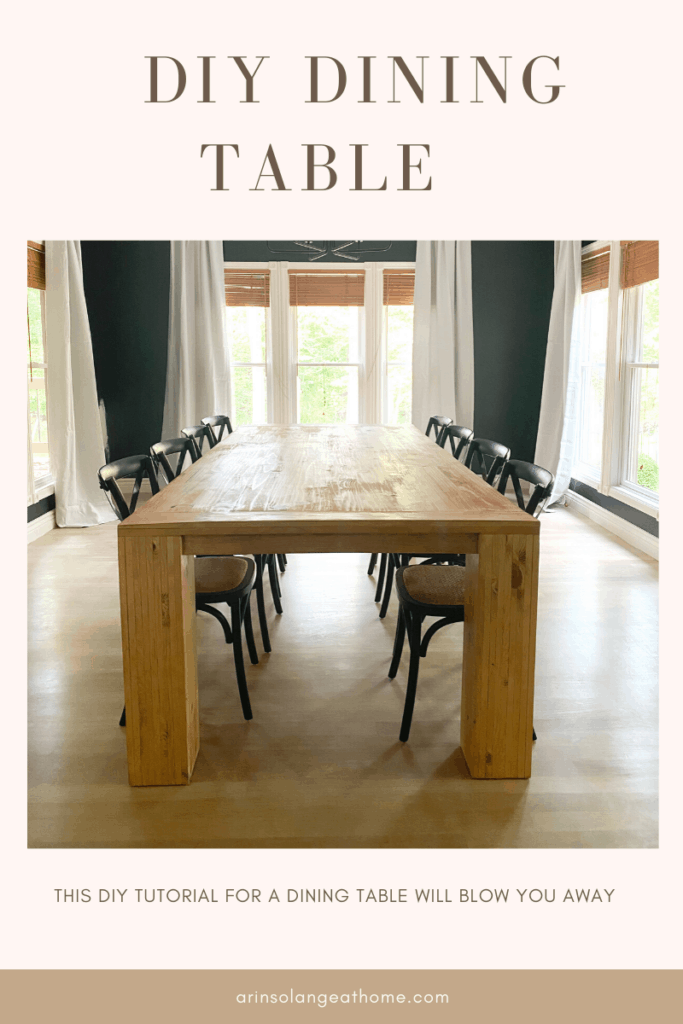

The stain color is missing can you please share?
Thank you! Just added it.